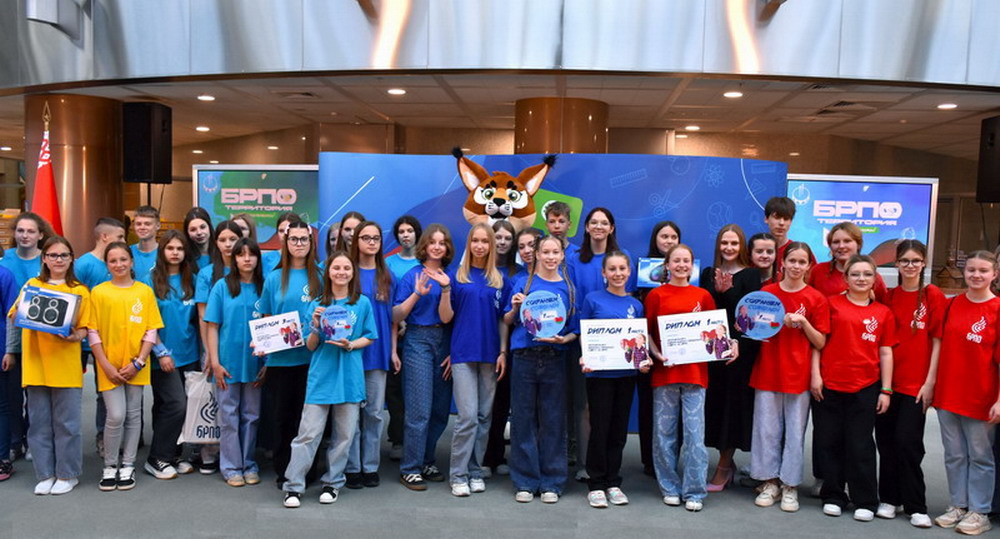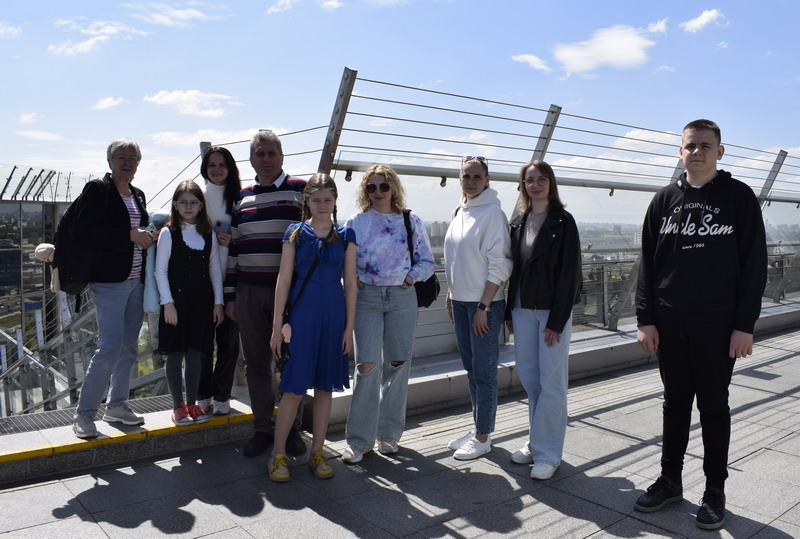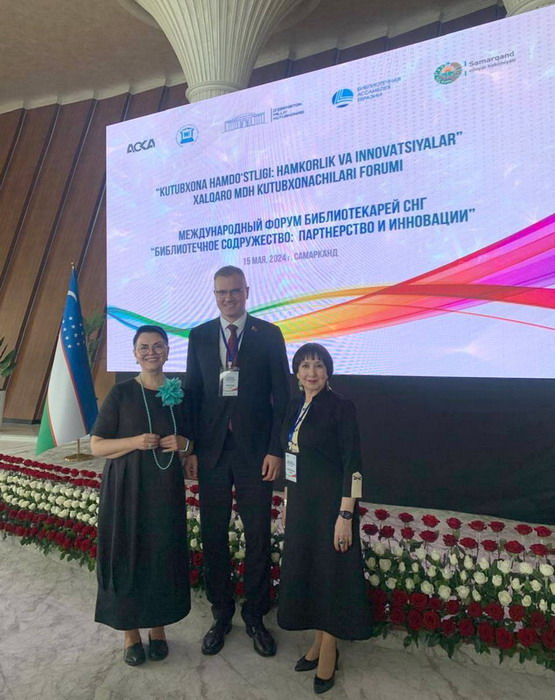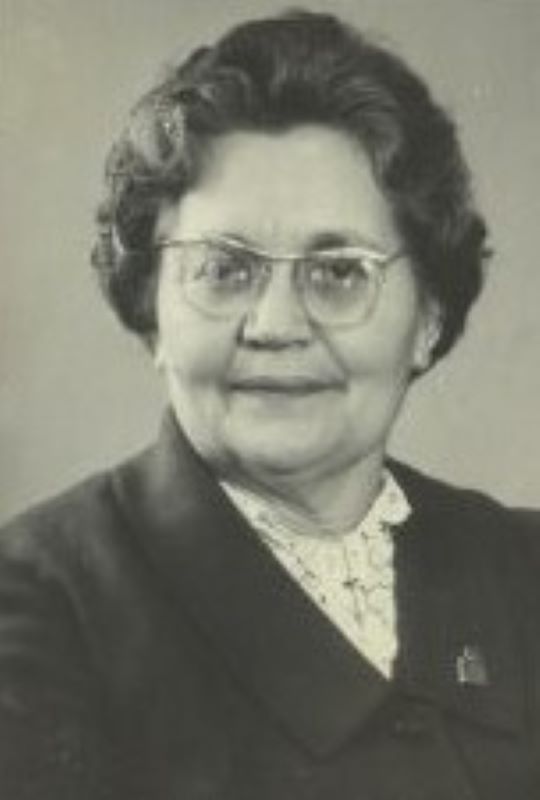A new project of the National Library of Belarus is dedicated to the Great Patriotic War – "Reading newspaper lines with your heart. On the 80th anniversary of the liberation of Belarus from the Nazi invaders."
Every week from January to August 2024, the portal of the National Library publishes materials from newspapers of Soviet Belarus in 1944, reflecting the chronicle of news and events of that time.
March 18th. In Belarus, Soviet troops released prisoners of the Ozarich death camps in the Gomel region. "Out of 50 thousand, 33 thousand people remained alive" [1418 days of the Great Patriotic War ..., p. 301; Ozarichi Camp].
21 March. "The VI session of the Supreme Council of the BSSR has begun its work in Gomel. The report was made by the Secretary of the Central Committee of the CP(b)B, Chairman of the Council of People's Commissars of the BSSR P.K. Ponomarenko."
March 22nd. In the Baranovichi region of Belarus, "the partisans of the G.K. Zhukov and Komsomolets brigades defeated a heavily fortified enemy garrison in [Orodskaya].p[touchstone]. The world."
[1418 days of the Great Patriotic War..., p. 301].
The partisan struggle continued. In a large article "Baranovichi partisans"LINK ["Savetskaya Belarus", No. 46, p. 2] it was told about the Baranovichi region – several detachments operated here; in the next issue of the newspaper – about the actions of partisans in Polesskaya, Vitebsk and other regions of Belarus ["Savetskaya Belarus", No. 47, p. 3]. There was daily military life behind enemy lines – posts, reconnaissance, communications, preparation and execution of combat missions – undermining echelons, bridges, roads, seizure of ammunition depots and food supplies, destruction of enemy manpower, saving their population from enemy punitive operations, mobilization for work in Germany or the German army.
And the photograph in the newspaper shows classes at a school organized in a partisan detachment for children [Savetskaya Belarus, No. 47, p. 3]:
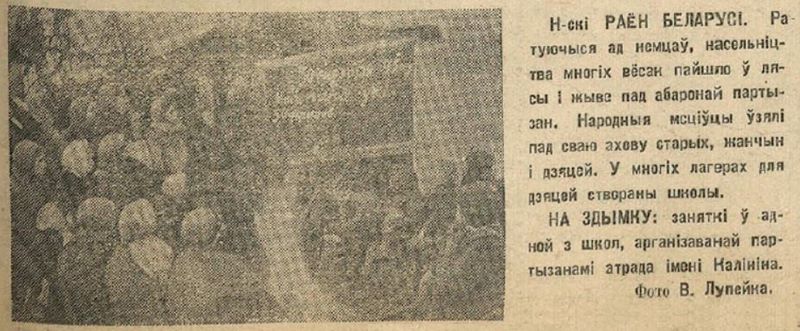
According to the military, the most important task was the timely carrying out of spring sowing operations to obtain a high yield. At the session of the Supreme Soviet of the USSR, it was noted that in 1943 it was possible to provide the Red Army and the population with food without serious interruptions, and industry with raw materials. Hundreds of thousands of women, having been trained to work on complex agricultural machines, have replaced men. Disadvantages were also noted, among which were the simplification of agricultural techniques of field work and the deterioration of crop care, which led to a decrease in yields. The materials of the session are posted on several pages of the newspaper "Savetskaya Belarus" [No. 45, pp. 1-3]. The article "To meet the sowing in combat readiness"LINK provides data on the state of agriculture in Polesie before the war and after liberation, urgent tasks are noted: check seeds for germination, teach cows to walk in a yoke (due to a shortage of tractors) ["Savetskaya Belarus", No. 48, p. 2].
Specialist agronomist in the newspaper "Stalinskaya Prayda" LINK [No. 12, p. 2] published an article in which he described in detail how to prepare potatoes for planting so that the harvest was higher.
Fundraising for planes and tanks for the Red Army continued. In general, more than 6 million rubles were transferred from employees of Gomel and the Gomel Region to the Homeland Defense Fund [Savetskaya Belarus, No. 48, p. 3]:
The collective farmers of the Zhuravichy district of the Gomel region sent five submarines to the Rogachev Guards division, whose fighters liberated this area [Savetskaya Belarus, No. 45, p. 3]:
And the wounded of one of the hospitals thanked the workers of the glass factory for the gifts they received ["Savetskaya Belarus" [No. 45, p. 4]:
After the liberation, pensions were restored in Mozyr, 4 orphanages were opened, 400 children were admitted to them, and great financial assistance was provided to the families of front-line soldiers ["Savetskaya Belarus" [No. 45, p. 4]:
In the Vitebsk region, the work of hospitals and pharmacies was restored ["Savetskaya Belarus" [No. 46, p. 3]:
The peat bogs of the Mogilev region were preparing for the beginning of the peat extraction season, a group of specialists studied at courses organized by the People's Commissariat of the Fuel Industry [Savetskaya Belarus [No. 48, p. 2]:
Almost until the 1970s, peat was the main type of fuel in Belarus, and it is still mined today [Poplavsky, G. In the nearest...].Railway tracks and bridges were restored ["Savetskaya Belarus" [No. 48, p. 4]:
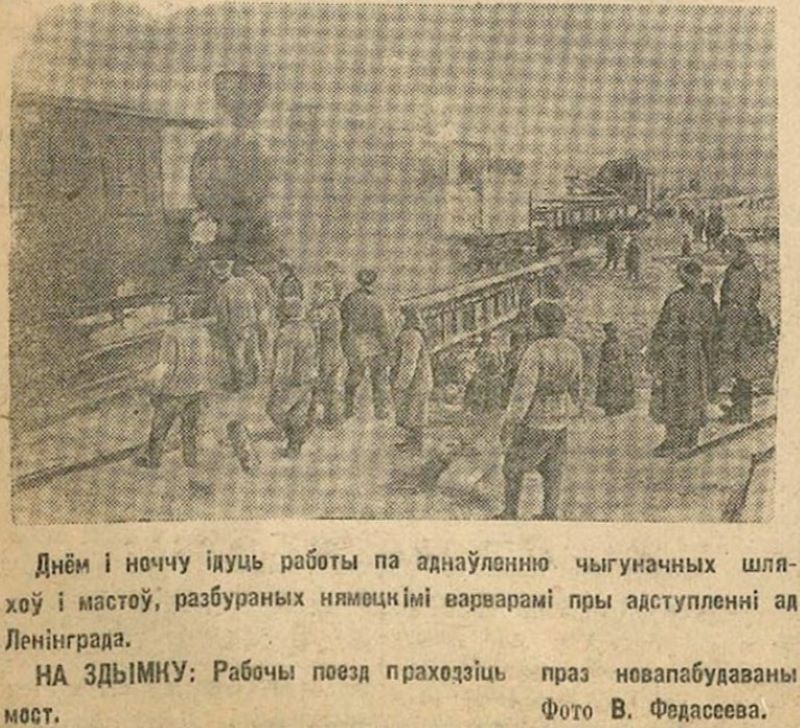
Educational institutions continued to open in the liberated areas.
We had to come up with new methods of training in the production itself. One of the tasks of the integrated teams on the railway was to organize and carry out a complete repair of locomotives. But the lack of qualifications of a number of crew members (conductors, conductors) significantly slowed down the process. So one of the railway machinists tried and implemented the innovation – he organized training within the brigade itself, both theoretical and practical (from locomotive construction to plumbing). And the repair business accelerated, and other teams decided to support the innovation. The innovator also received a telegram with the support of the initiative from the People's Commissar L. M. Kaganovich ["Savetskaya Belarus" [No. 46, p. 2]:
The Union of Writers of the BSSR organized the publication of the journal "Belarus" ["Savetskaya Belarus", No. 46, p. 4]:
"Belarus" is a monthly illustrated socio-political magazine; founded by the Union of Writers of Belarus, published since January 1944; in 1944 it was published in Belarusian and Russian (No. 1-3 in Moscow, then in Minsk), since 1945 – in Belarusian. The publication continues today, since 2005 it has been called "Belarus".
The first two issues of the magazine are illustrated below.
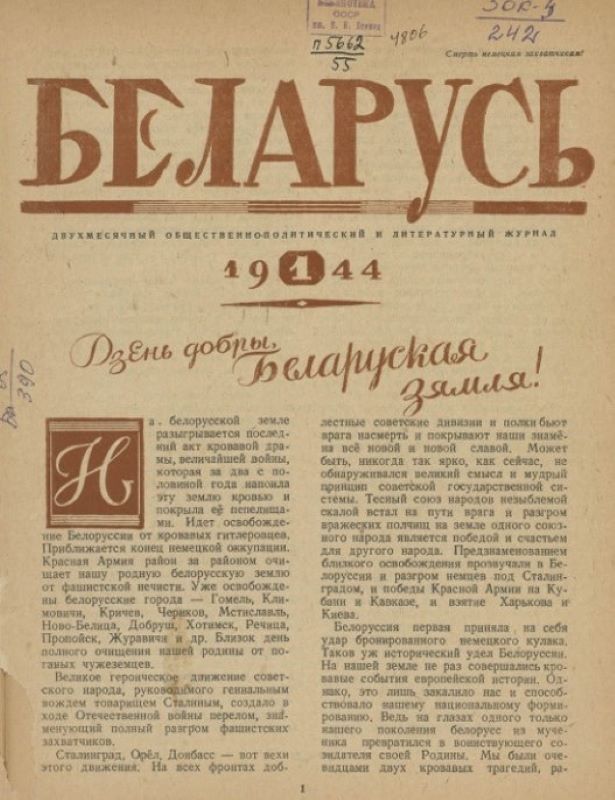
|
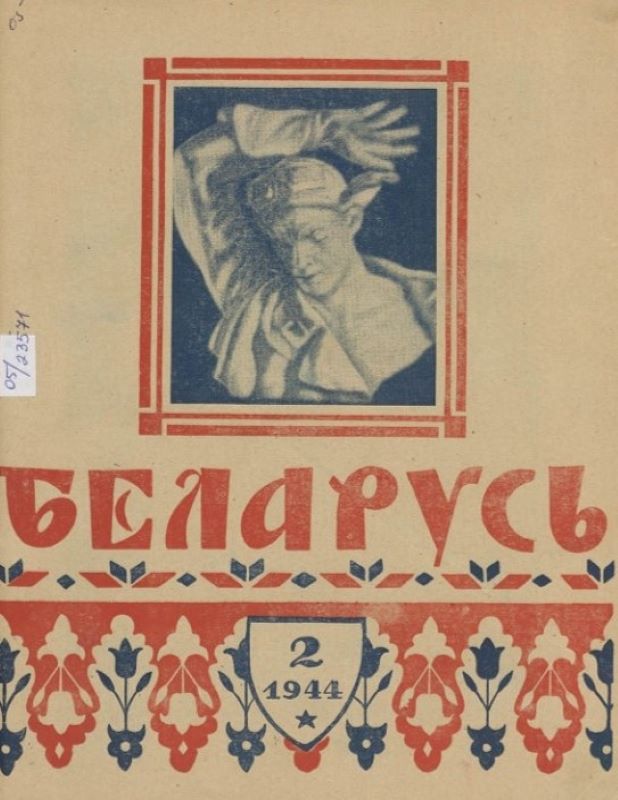
|
|
The title page of the magazine "Belarus", 1944, No. 1. From the NLB foundation.
|
Cover of the magazine "Belarus", 1944, No. 2. From the NLB foundation.
|
The photo of the second issue shows a portrait of N. Gastello by sculptor Andrei Onufrievich Bembel (1905-1986), a Belarusian Soviet sculptor, People's Artist of the BSSR (1955), one of the founders of the monumental art of Belarus.Interesting and significant news from the cinematic life is about the creation of a film dedicated to his native Belarus ["Savetskaya Belarus", No. 48, p. 4]. "It was the first film created by Belarusian directors during the Great Patriotic War" [Chronicle of Victory].
In the USSR, even in war conditions, they decided to widely celebrate the 100th anniversary of the outstanding Russian composer Nikolai Andreevich Rimsky-Korsakov (1844-1908), with a full academic edition of his works, the installation of a monument, etc. ["Savetskaya Belarus" [No. 46, p. 1]:
In 1944, the Leningrad Conservatory, where he worked for about 40 years, was named after Nikolai Andreevich Rimsky-Korsakov. House Museum in Tikhvin (Leningrad region) It was opened on July 23, 1944. A sculptural monument was erected near the conservatory building on Teatralnaya Square in 1952. The complete works were prepared and published from 1946 to 1970. And nowadays, from March 15 to 18, 2024, an international festival in honor of the 180th anniversary of the great Russian classic, with the participation of the Bolshoi Theater of Belarus, was held in twenty cities of Russia [International Festival...].There were 23 weeks left before the Liberation…Pleasant news from the Novobelitskaya regional library – an exhibition of books about famous generals – Alexander Nevsky, A. Suvorov, M. Kutuzov, V. Chapaev and others is organized here ["Savetskaya Belarus" [No. 45, p. 4].
The Novobelitskaya Library (now the Library-Branch No. 3 named after Evdokim Romanov of the State Institution "Network of Public Libraries of the city of Gomel") celebrated its 100th anniversary in 2019. After liberation, the Novobelitsa City Library began operating on December 7, 1943. In 1993, by decision of the Gomel City Executive Committee, the library was named after an outstanding ethnographer, folklorist and native of Novobelitsa - Evdokim Romanov.
The material was prepared by L. G. Tupchienko-Kadyrova,
Candidate of Historical Sciences, chief bibliographer
of the information and analytical department.
Sources
Newspapers*
The full news papers issues are available on links.
- Беларусь. Belarus : палітыка, эканоміка, культура : штомесячны часопіс / заснавальнікі: Міністэрства інфармацыі Рэспублікі Беларусь, Установа Адміністрацыі Прэзідэнта Рэспублікі Беларусь, Рэдакцыя газеты “Советская Белоруссия”, ААТ “Белзнешэканамбанк”. – 1944–. – Мінск : Рэдакцыя газеты “Советская Белоруссия”, 1944–.
- Калгаснік Капыльшчыны : орган Капыльскага райкома КП Беларусі і раённага Савета дэпутатаў працоўных, 1944, № 13.
- Раздавім фашысцкую гадзіну : газета-плакат : выданне ЦК КП(б) Беларусі. – 1944, № 124–125. – С. 4.
- Савецкая Беларусь : орган ЦК КП(б) Беларусі, Саўнаркома і Прэзідыума Вярхоўнага Савета БССР, 1944, № 45.
- Савецкая Беларусь, 1944, № 46.
- Савецкая Беларусь, 1944, № 47.
- Савецкая Беларусь, 1944, № 48.
- Савецкая Беларусь, 1944, № 49.
- Сталінская праўда : орган Веткаўскага РК КП Беларусі і Райсавета дэпутатаў працоўных, 1944, № 12.
*The titles of the newspapers are given accordance to modern spelling.
Resources
- Аладава, А. Мастакі ў дні Айчыннай вайны // Беларусь. – 1944. – № 2. – С. 52–54.
- Международный фестиваль “День Римского-Корсакова” пройдет с участием Большого театра Беларуси // Інфармацыйна-аналітычны партал Саюзнай дзяржавы. – Рэжым доступу: https://soyuz.by/obshchestvo/mezhdunarodnyy-festival-den-rimskogo-korsakova-proydet-s-uchastiem-bols.... – Дата доступу 11.03.3024.
- Лагерь “Озаричи” : 10 дней, которые потрясли всех // Праект газеты “7 дней” : “Карта памяти”. – Рэжым доступу: https://specreport.belta.by/ozarichi. – Дата доступу 11.03.2024.
- Осенев, Н.И. Весть о награде [Изоматериал] : [открытка] / художник Н.И. Осенев. – [Москва] : Советский художник, 1950. – 1 л.
- Поплавский, Г. В ближайшей перспективе в стране запланировано строительство 3 700 гектаров новых торфяных полей / Г. Поплавский // СБ. Беларусь сегодня. – 2021. – 4 нояб. – Рэжым доступу: https://www.sb.by/articles/torf-zdes-umesten-toplivo.html. – Дата доступу 13.03.2024.
- Римский-Корсаков, Н.А. Полное собрание сочинений [Ноты] / редакционная комиссия: А.Н. Дмитриев [и др.]. – Москва : Музыка, 1946–1970.
- 1418 дней Великой Отечественной войны : хронология событий : хронология событий : [солдату Великой Отечественной посвящается / сост. Е. В. Малашевич ; науч. ред.: Е. И. Барановский, Г. И. Баркун ; фото: В. В. Харченко]. – Минск : Мастац. літ., 2014. – 421, [1] с.
- Хроника Победы: день за днем // Праект БЕЛТА. – Рэжым доступу: https://peramoga.belta.by/ru/hronika_pobedy/?id=272452. – Дата доступу 13.03.2024.
- Хроніка. 25-годдзе сцэнічнай дзейнасці У.І. Уладамірскага // Беларусь. – 1944. – № 2. – С. 61.
- Хроніка. Новая п’еса “Паляшукі” // Беларусь. – 1944. – № 2. – С. 61.


